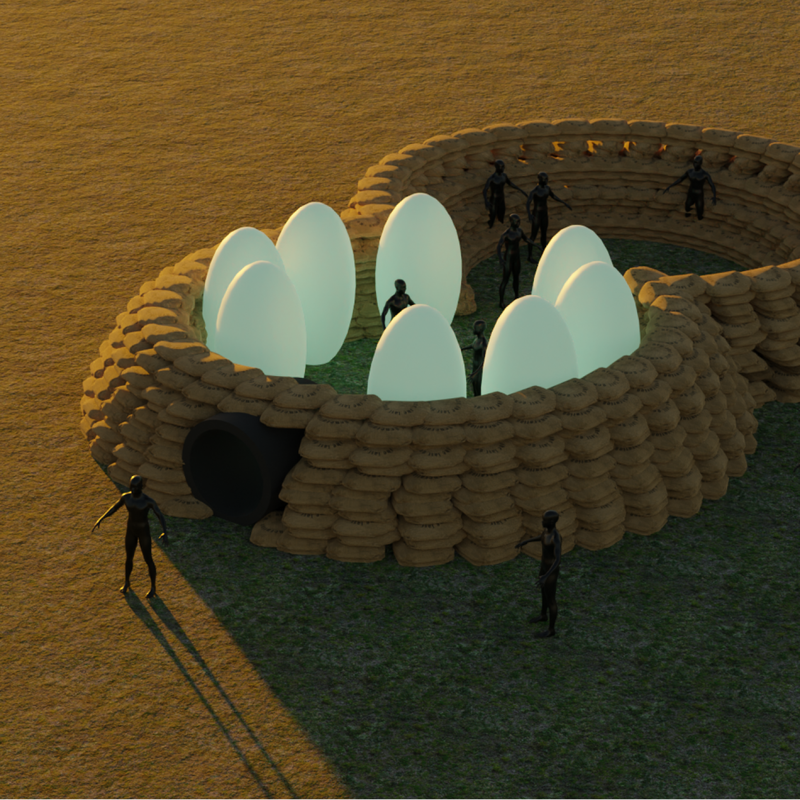
Visual stage at Pohoda 2023
Visual art has been part of Pohoda for several years. This year, for the first time, a work is created directly just for our festival. It is created by András Cséfalvay, who will reflect on the topic of the climate crisis. Of course, you can also expect many other and great works that are part of the Visual stage.
30. June 2023
Pohoda Visual Stage is a virtual platform for the visual arts. Its identity and content are gradually evolving, just like the global context in which we live. The war in Ukraine and the promotion of Ukrainian culture will appear at this year's festival in various forms of artistic expression and discussion. Due to the war and the security, political and economic problems we are currently facing, which need to be urgently addressed, we are postponing the solution to the most pressing challenge facing humanity – whether we still have a chance to survive on a shared planet. However, we have no choice but to address all these issues simultaneously.
That is why we have invited artists who have been drawing attention to pressing environmental issues and the ecological crisis for a long time and who confront us with the vulnerability of our ecosystem. We present artists who have made a programmatic commitment to these issues.
In addition to Rudolf Sikora, Oto Hudec and Tamara Kametani, we also present András Cséfalvay, who created a new work for Pohoda that asks the question: “Are we the last generation?” The work – worldview and mindset of Šimon Chovan, winner of this year's Visual Art Contest – will be on display at various locations around Pohoda venue. It will 'parasitise' on man-made structures, representative of the creatures with whom we share a common home.
The special Art Contest prize was awarded to the work of the student group Bahno 974. Pohoda visitors can meet a bizarre animal – the mutant CASTORIN – trying to adapt to the conditions of the geological epoch of Anthropocene. The work was created in cooperation with the University of Fine Arts in Bratislava.
Last year there was another tragedy in Slovakia that shook society. We cannot and will not ignore the issue of LGBTIQ+ rights as well as minority rights and equality in society. Since the murder of the innocent young people, Visual Stage, in cooperation with the Nová Cvernovka Foundation, University of Fine Arts and Matej Bel Institute, has organised a series of discussions throughout Slovakia entitled Tepláreň nahlas (Tepláreň Out Loud), with the aim of raising awareness of minority issues in society, with a special focus on the LGBTIQ community. To this end, we have invited Kristián Németh with his exhibition Modlitba za lepšiu budúcnosť (Prayer for a Better Future), created in cooperation with the Peter Michal Bohúň Gallery in Liptovský Mikuláš. Visitors to the exhibition can see facsimiles of Ladislav Mednyánszky's drawings, and there is also a surprise waiting for them.
See what awaits you at Pohoda 2023 this year as part of the Visual stage:
András Cséfalvay: Last generation
The impact of an asteroid on Earth caused the extinction of many animals. It happened unexpectedly, many were planning their future, family, or career. Only a few fossil nests with intact eggs buried in earthen mounds remained after the dinosaurs. The fragility of the shells can remind us of the vulnerability of life, the extinction that humanity has brought upon itself. However, if we look up and a bird flies over us, we realize that flight is one of the adaptations of dinosaurs that allowed them to survive. Birds are dinosaurs that learned to fly. So, is there hope for humanity? The installation of eight three-meter-high eggs protected by a wall of sandbags creates a space for thinking and discussing the current (sixth) mass extinction.
Last Generation debates:
FRIDAY:
11.30 – 12.30 : Thomas Moynihan (GB)
Writer interested in the history of ideas and future
14.00 – 15.00 : Dennis Hansen (CH)
Zoological Museum of the University of Zurich Curator, Evolutionary biologist
SATURDAY:
11.30 - 12.30 : András Cséfalvay (SK)
Krehkosť života a nebo (Modely k prežitiu)
14.00 - 15.00 : Znepokojené matky (SK)
Ako mať dieťa v klimatickej kríze?
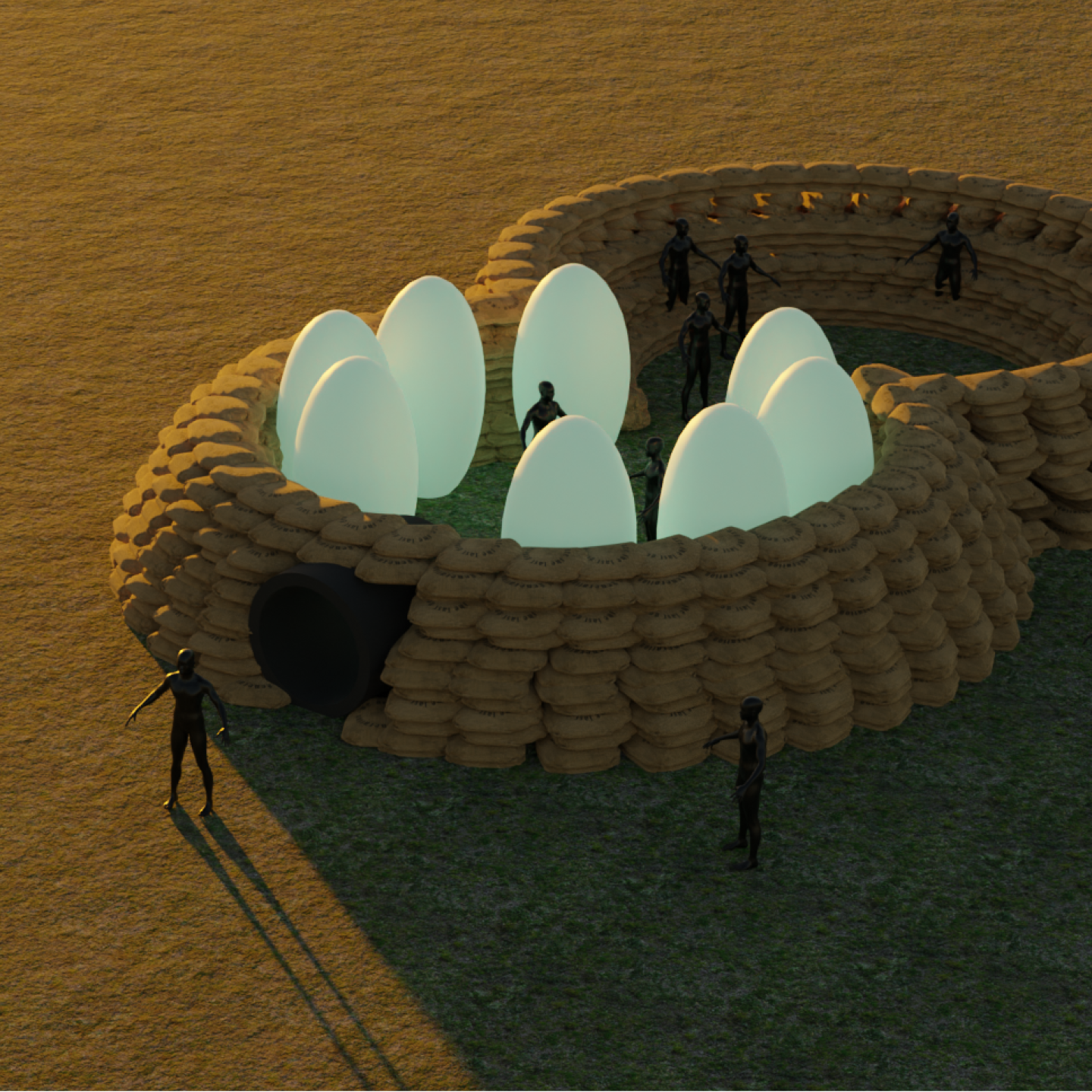
Tamara Kametani: The End in Three Parts, Part One
Part One is the first in a series of works that present possible future trajectories. It describes an unlikely refuge from ubiquitous surveillance in the form of an island that, until now, existed only as a virtual dumping ground for corrupted data. Named after its geographical coordinates of 0.0, Null Island is the embodiment of the possibility of a better, freer, and fairer world. Oscillating between utopia and dystopia, Part One tells the story of a religious, grassroots resistance in a world with few freedoms left.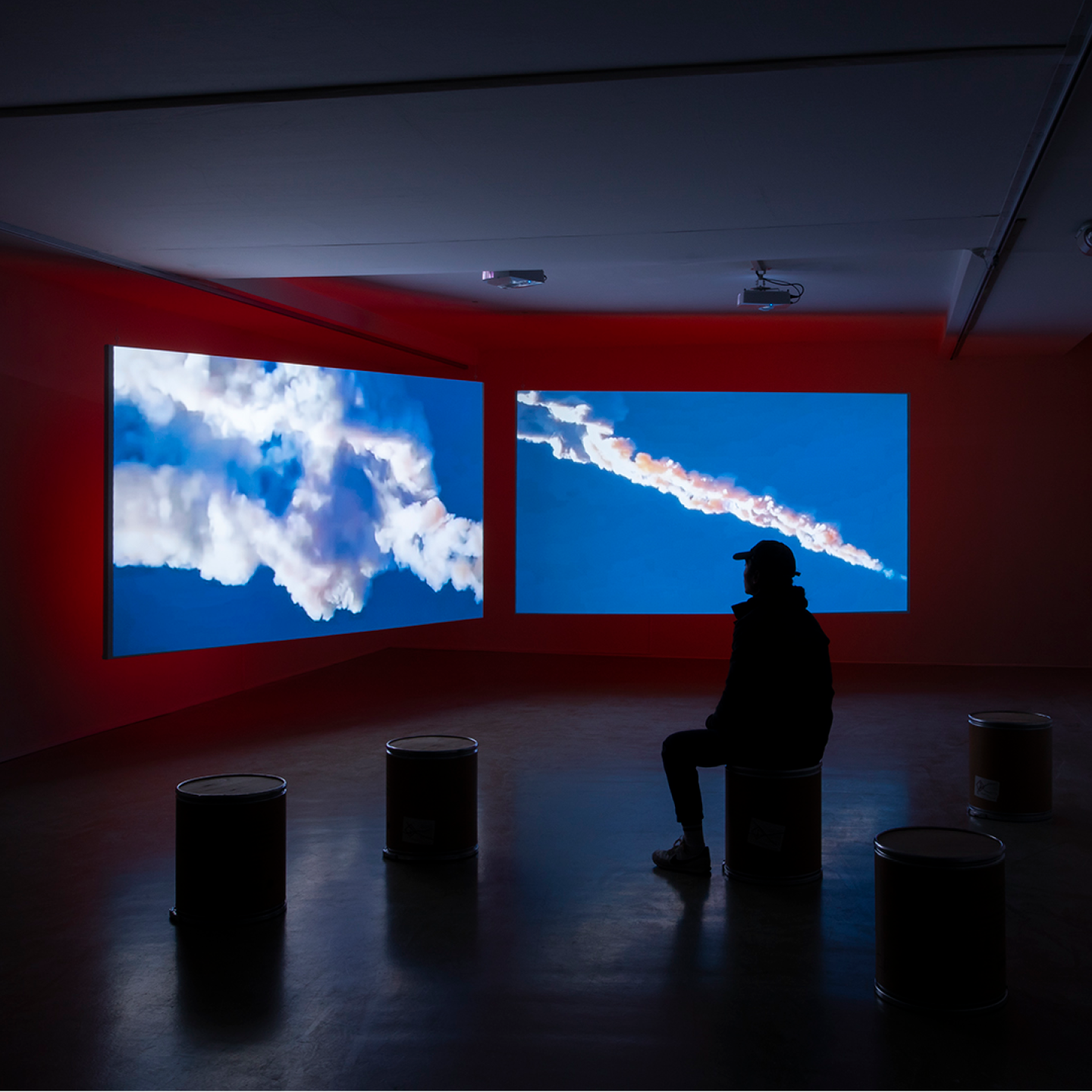
In his projects, visual artist Peter Kašpar deals with the themes of cultural movements and intersections in the broader context of racial relations, ethics, artificial intelligence, and the limits of human consciousness. The audio-visual work entitled Sonic Coding plays out, in a 3D animation environment, poetic moments in slow motion that represent the main pillars of hip-hop culture: dance and rap, graffiti, DJ-ing or music production. These areas are rendered in hyper-realistic 3D form of actual hip-hop “situations” that also mimic the details of real-world “damage” (e. g. dirty trainers). The world of 3D animation, in a chameleon-like way, also acquires cultural features that lose their original justification in it.
In the work Sonic Coding, image, gesture, and pulsating movement are brought to the fore before the manifestation and rhetorical layer of hip-hop. As the American music columnist Simon Reynolds writes, “in rap, there is no difference between the rhetoric of 'beyond the grave' and the contractual reality of business relationships.” The rhetorical level is completely absent and is replaced by meditative music. This is part of the artist's choice to penetrate the layer of word and commodity and shift the attention to “the relatedness of all parts”. Related to this is the intention of softening the layer of trauma and violence that co-formed the forms of hip-hop. A key ingredient of the work thus becomes a care for the healing of the wounds contained in the legacy of hip-hop and compassion for the suffering that lies beneath the surface of the culture.
In cooperation with the Oskar Čepan Award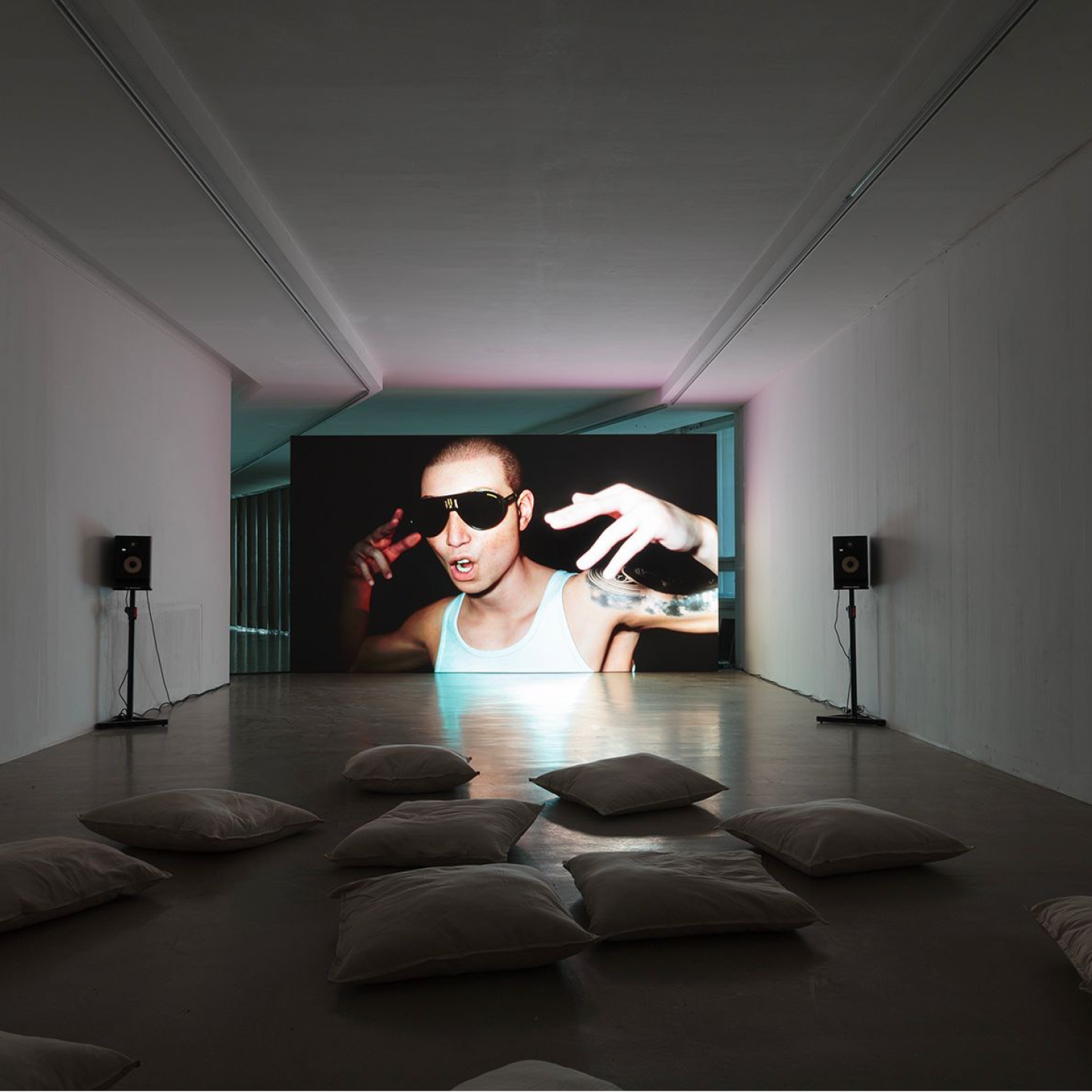
Rudolf Sikora: Nie politika, ale múdrosť ochráni našu civilizáciu!
“Let's not build a civilization in which we will kill each other! Let's not build a corrupt structure of political power! Let's build a civilization that can also handle climate change. Which can prevent it with its wisdom. Because it will build a human vision of its own...”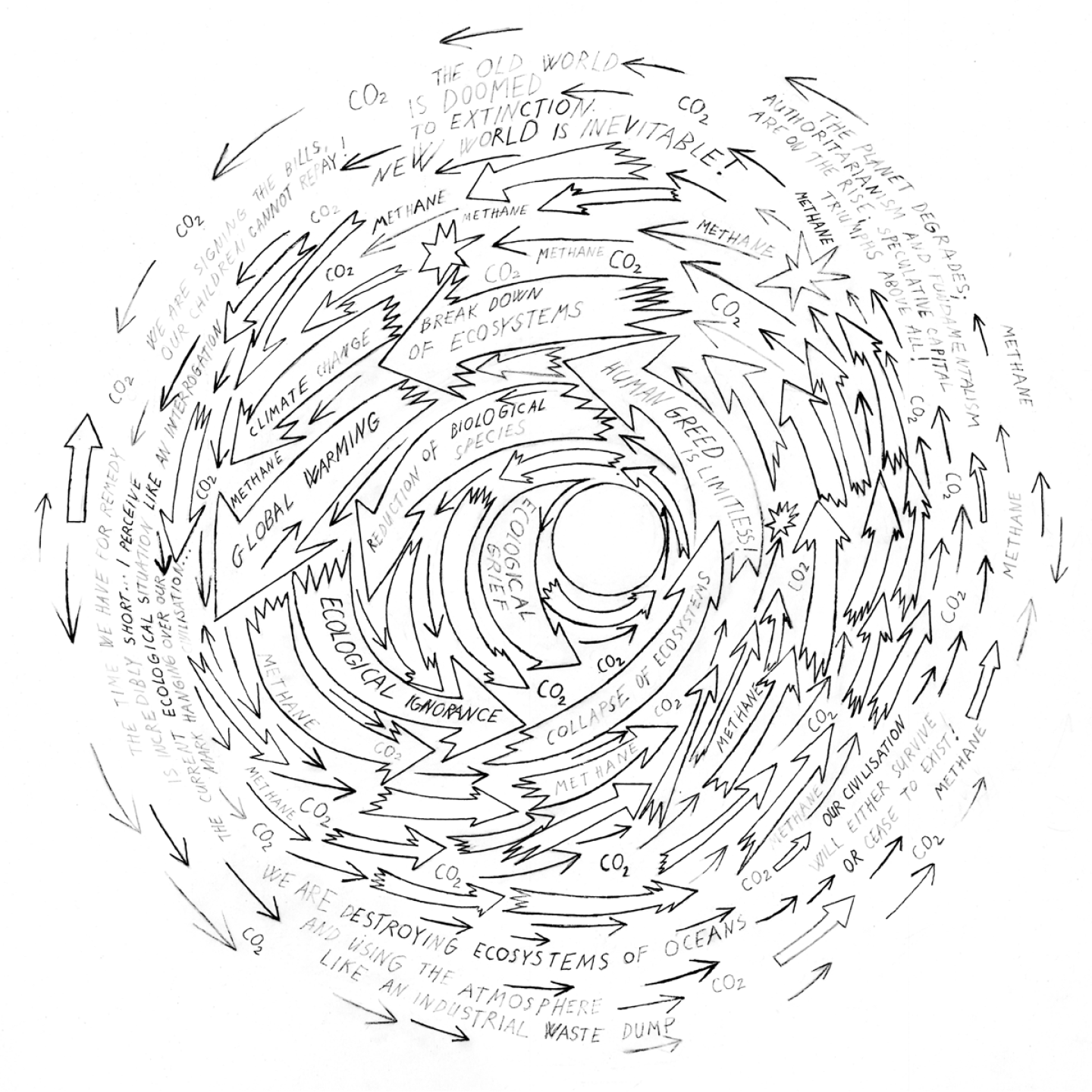
Oto Hudec: Vlajka modrej planéty
When astronauts look at Earth from space, they see a blue ball covered by layers of clouds, with the continents shining through. But what they don't see are the borders of the states that we know from political maps. Today, as we face the climate crisis, nations must learn to work together regardless of borders.
Industrialized countries account for the largest share of emissions, but the effects of climate change are most pronounced in the Global South, whose residents bear the least responsibility. For Earth Day in 1969, John McConnell designed the Earth flag. Since then, many have tried to design a universal blue planet flag, but not a single proposal has been successful. This Flag of the Blue Planet is based on McConnell's design, but instead of the image of Earth, it has a round hole. The sky seen through the hole visually resembles Earth as seen from space, but instead of a fixed image, the flag changes depending on the weather, highlighting the vulnerability of natural systems that humanity has disrupted.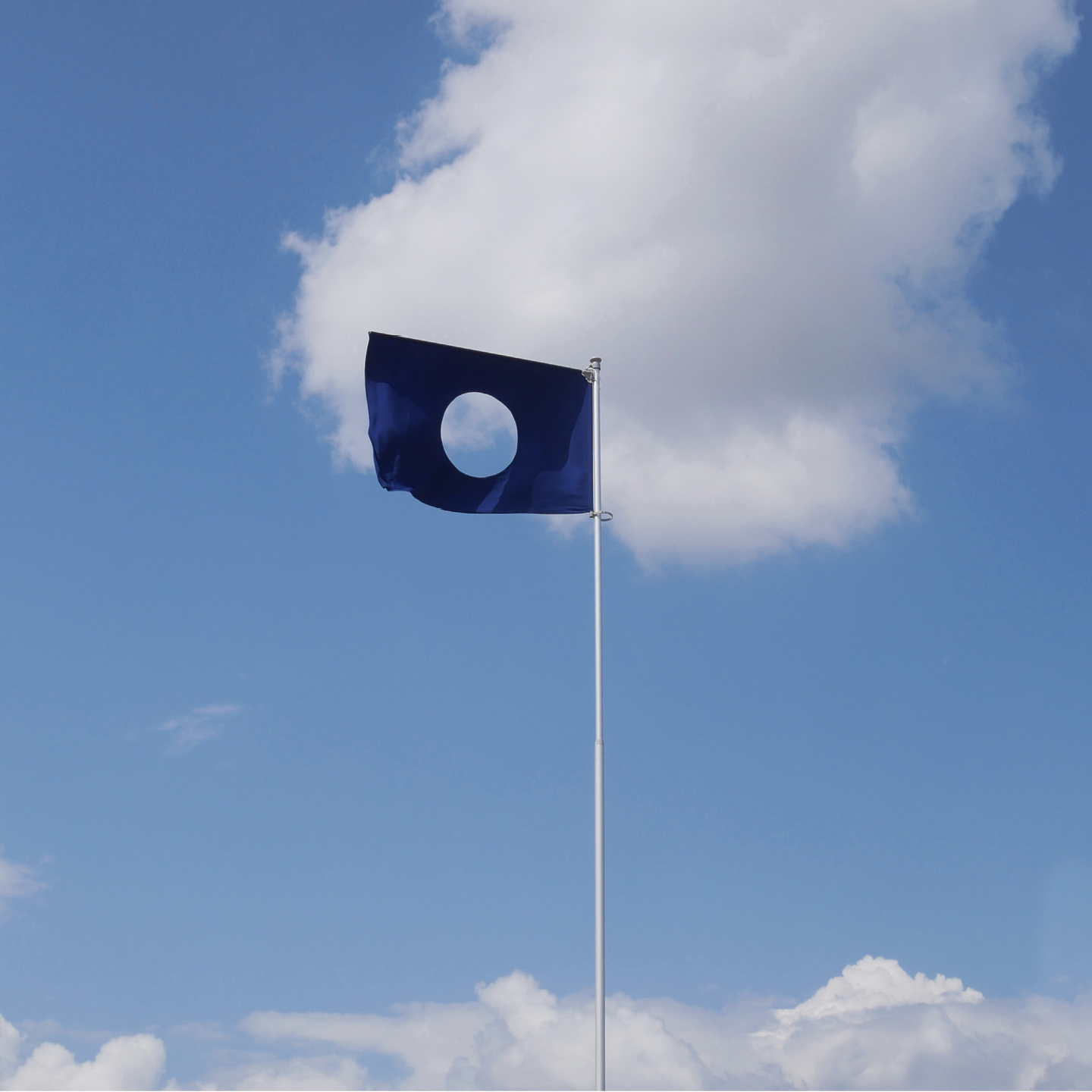
Kristián Németh: Oratio pro futuris melioribus / Modlitba za lepšiu budúcnosť
The solo exhibition of the visual artist Kristián Németh Oratio pro futuris melioribus / Prayer for a better future naturally follows the intermedial tendencies in his work that freely move from direct institutional criticism to the symbolic level and general themes. In his works, the artist communicates topics related to physicality, intimate and traumatic content, sexual minorities, and power relations in the context of the Catholic Church.
Oratio pro futuris melioribus / Prayer for a better future is a hybrid exhibition project that places a selection of Németh's emblematic works in a functional dialogue with the oeuvre of Miloš Alexander Bazovský (1899 – 1968) and Ladislav Mednyánszky (1852 – 1919) from the collections of the Liptov Gallery of Peter Michal Bohúň. Németh's experiment and selective research connect the past with the present, while purposefully reacting to the current political and social situation accelerated by the terrorist attack on Matúš Horváth and Juraj Vankulič outside Bratislava´s Tepláreň bar.
In Cooperation with Liptov Gallery of Peter Michal Bohúň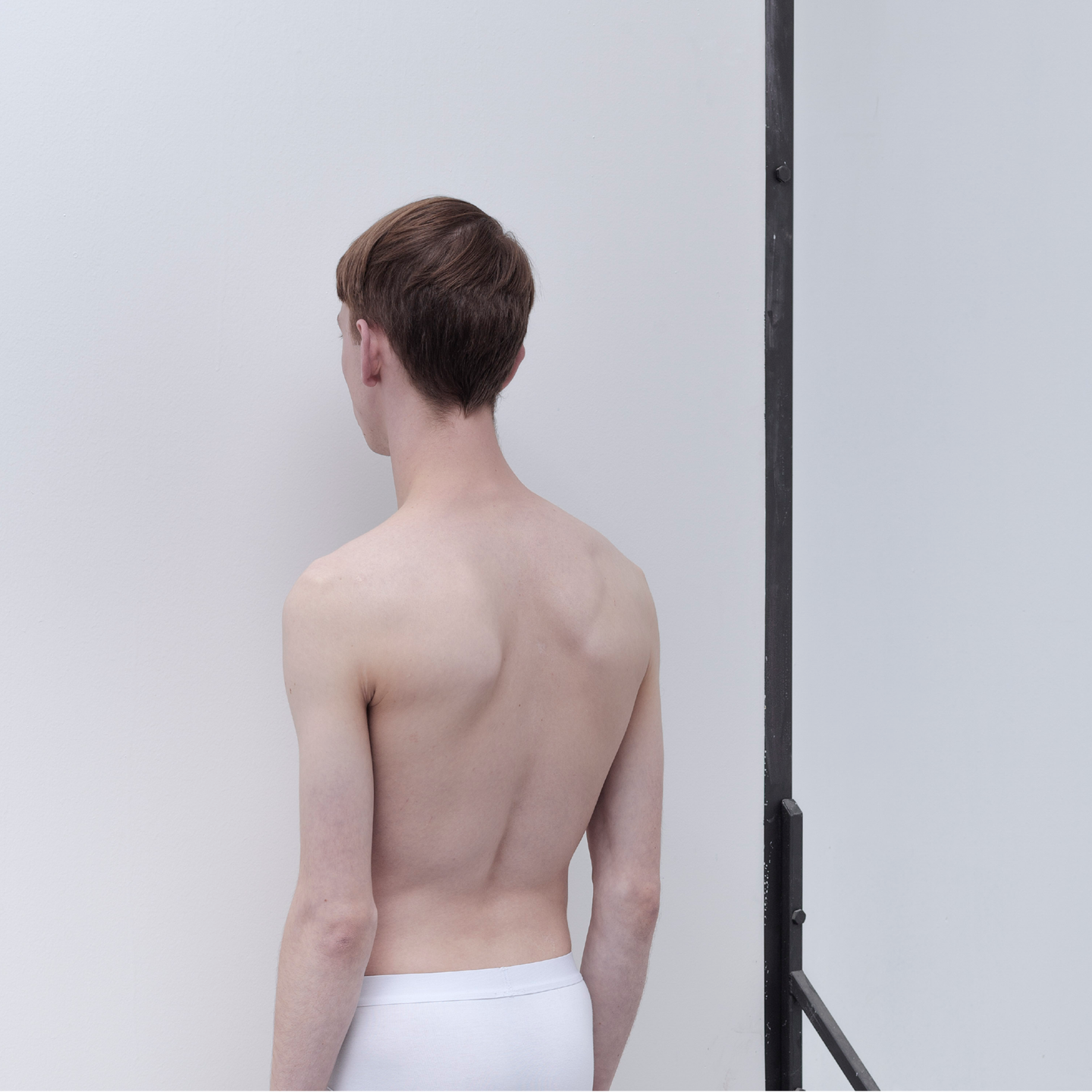
Stano Masár: Zjavujúca sa pamäť / Pozdrav môjmu zajtrajšiemu ja / Appearing Memory / Greetings to My Tomorrow Self
Stano Masár has prepared for the Visual Stage Pohoda 2023 a kind of continuation of his project from 2019. In the old newsstand, you can, once again, buy postcards, which, after writing and sticking a stamp, you can drop into the mailbox right “behind the corner of the stand”. However, unlike 2019's “moving monument” to the Velvet Revolution of 1989, the artist now appeals to the future.
The newsstand model is the same as it was four years ago, but now it's faded. The newspapers in the windows are also faded. All that remained was a newsstand with newspapers without any content. Between-state, between-time, between-space... But you can read the texts on the postcards in the window. Texts, clippings of imaginary headlines of articles from newspapers and magazines. Good and bad news, color-coded with red and black frames. Postcards can be bought, written, and sent, either to yourself, your loved ones, or acquaintances.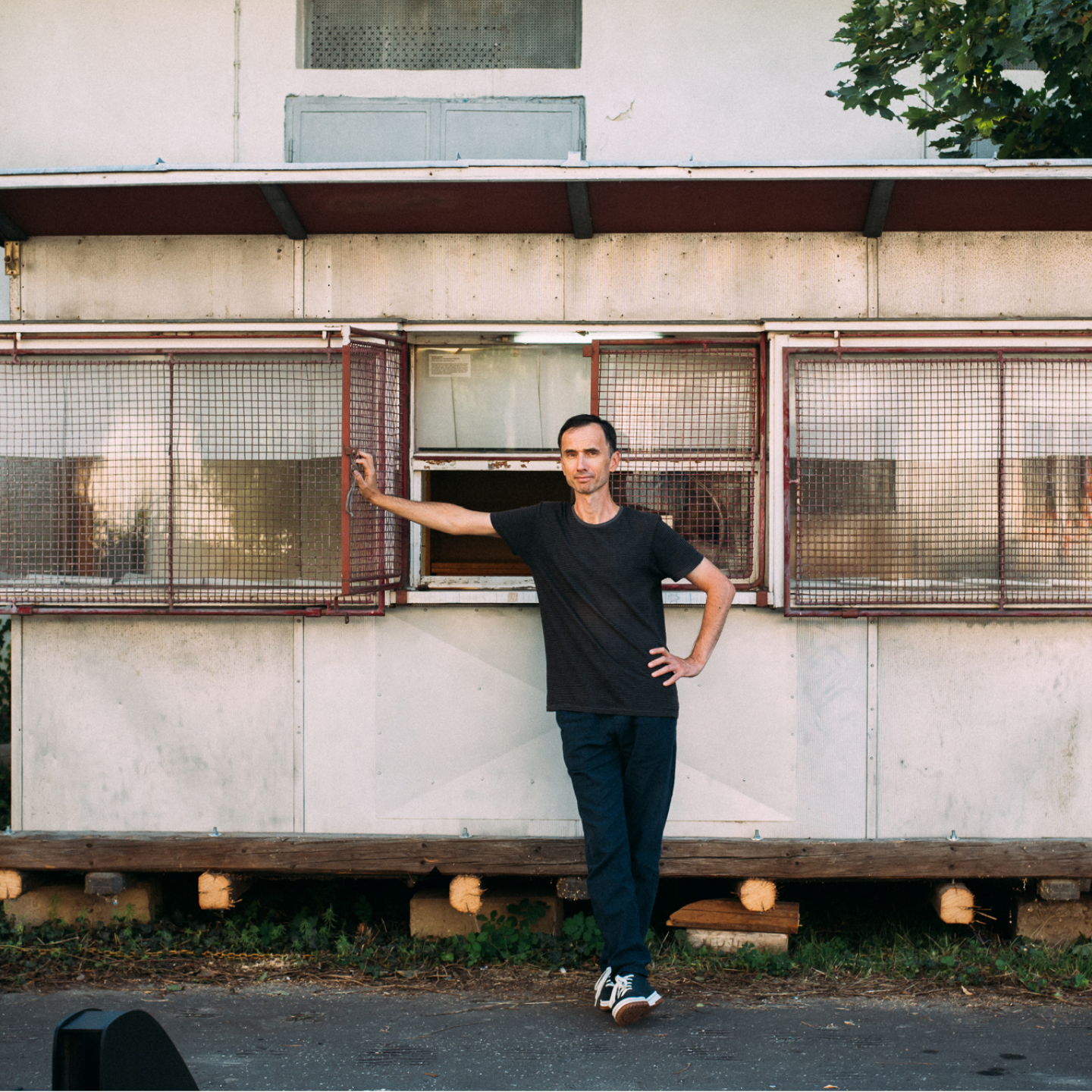
BAHNO 974 / MUD 974: CASTORIN
Mário Coufal a Volodymyr Serhachov
The concept of the CASTORIN project deals with the topic of water pollution and offers the prospect of a “mammal” of the future. This creature, vaguely resembling the local fauna, an otter, or a beaver, still bears the characteristics of the original animals, but is deformed, mutated by elements of modern technology. Its mutation occurred as a result of long-term living in a polluted habitat, where it had to adapt to new, complex conditions. It is an animal that has found itself outside of its “natural” environment, and it is searching the soil for any fragments of information on how to get back to its native environment, because it does not have much time left.
The aim of the work is to evoke a feeling of melancholy, since it is, after all, a creature that has found itself outside of its home. At the same time, it wants to be a warning finger that points to our rich biodiversity that is being deformed and degraded every day. He wants to present an unpleasant view of a creature, which is perhaps only the beginning of the absurdity, which might become reality due to the irresponsible behaviour of mankind.
In cooperation with the AFAD in Bratislava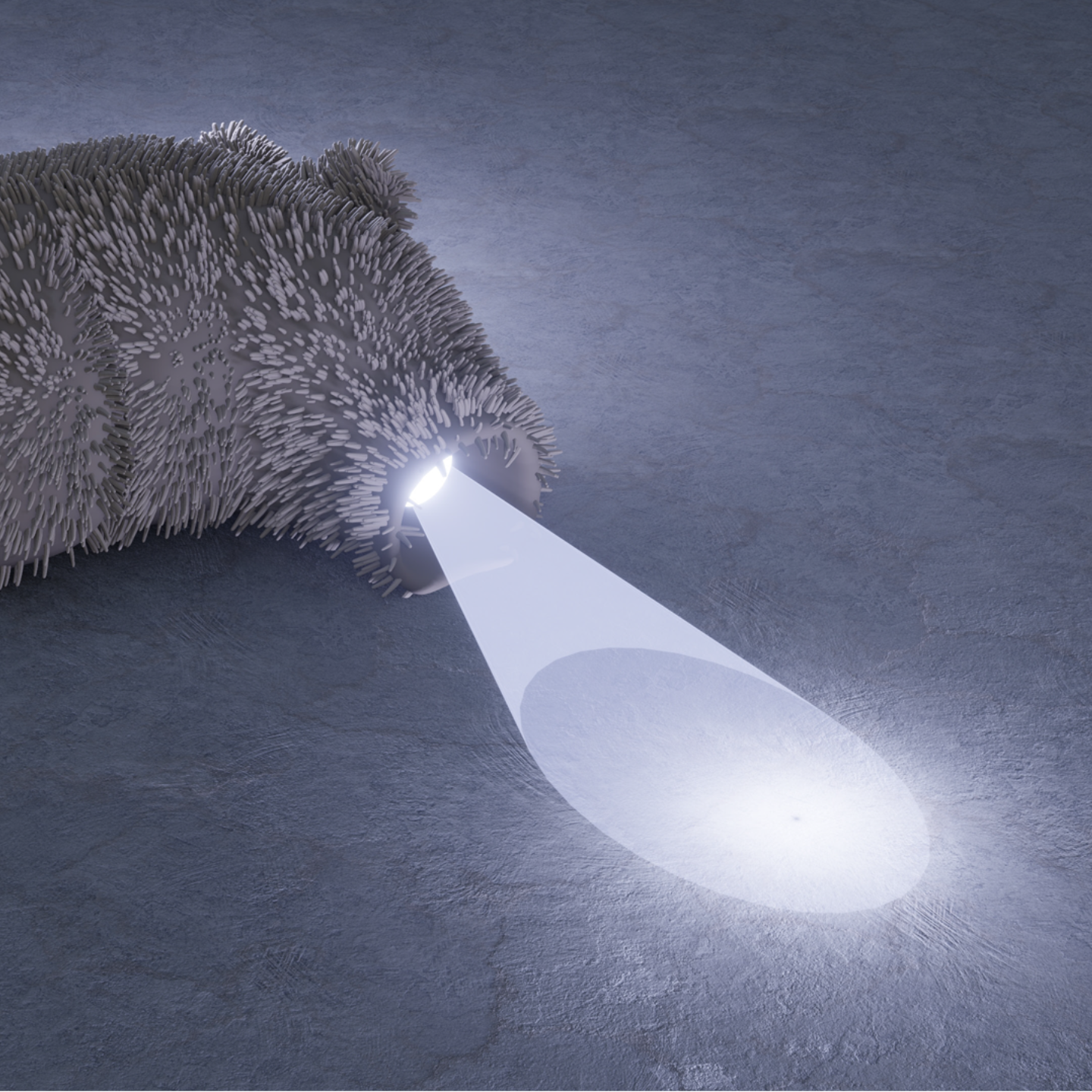
Dear Thearlings is an unfinished series of soft sculptures. Their common element is the casting of silicone industrial materials (food containers, industrial flowerpots) with natural pigments. Castings covered mainly with ocher soil from Štiavnica Mountains the artist subsequently uses as the skin of the objects. They look like they were just pulled from the ground, thousands of years old, but their technical texture refers to genetic modifications or synthetic biology. They create tension at the interface of several categories - concrete, abstract (developmental stages of insects or something unknown), living/inanimate, human/non-human, fragile/solid, beginning/end. In the forms of cocoons or larvae, the conflicting temporal categories of short transitional developmental stages of insects accumulate over millions of years of geological time during which the ocher pigment was formed.
The work disrupts the traditional parameters of a typical sculpture in festival spaces. It is not a monumental, clearly defined, or visible gesture from afar, but a series of unpredictable interventions in unexpected places. It highlights the existing architecture of the festival and uses its infrastructure the way a symbiote uses the body of another organism. The moment of surprise is also a reference to the ongoing climate change, which has disrupted the stability and predictability of the environment.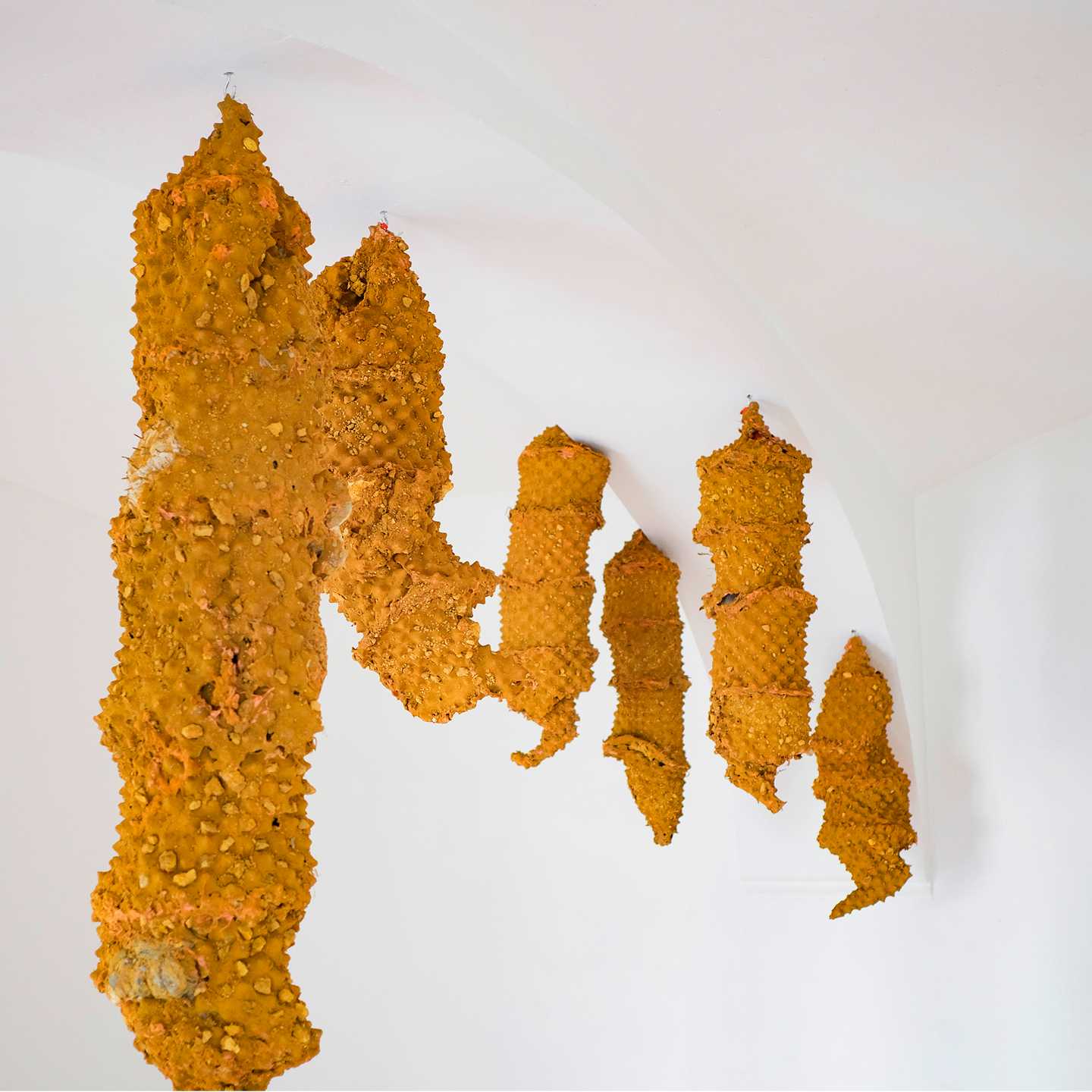
---
Curator: Ilona Németh
Cooperation and production: Daniel Dida, Michal Kaščák





